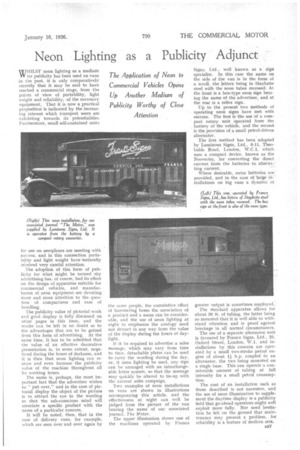Neon Lighting as a Publicity Adjunct
Page 55

If you've noticed an error in this article please click here to report it so we can fix it.
[-ULM' neon lighting as a medium VV for publicity has been used on vans in the past, it is only comparatively recently that it may be said to have reached a commercial stage, from the points of view of portability, light weight and reliability, of the necessary equipment. That it is now a practical proposition is indicated by the increasing interest which transport users are exhibiting towards its potentialities. Furthermore, small self-contained units Signs, Ltd., well known as a sign specialist. In this case the name on the side of the van is in the form of a scroll, the letters being in Staybrite steel with the neon tubes recessed: At the front is a box-type neon sign bearing the name of the advertiser, and at the rear is a reflex sign.
Up to the present two methods of operating neon signs have met with success. The first is the use of a compact rotary unit operated from the battery of the vehicle, and the second is the provision of a small petrol-driven alternator.
The first method has been adopted by Luminous Signs, Ltd., 5-11, Theoholds Road, London, W.C.1, which uses a compact device, known as the Neoverter, for converting the direct current from the batteries to alterna• ting current.
Where desirable, extra batteries are provided, and in the case of large installations on big vans a dynainO Of for use on aeroplanes are meeting with success, and in this connection portability and light weight have naturally received very careful attention.
The adoption of this form of publicity for what might be termed sky advertising has, of course, had its effect on the design of apparatus suitable for commercial vehicles, and manufacturers of neon equipment are deveting more and more attention to the question of compactness and •ease of handling.
The publicity value of pictorial work and good display is fully discussed on other pages in this issue, and the reader can be left in no doubt as to the advantages that are to be gained from this form of advertising. At the same time, it has to be admitted that the value of an effective decorative presentation is, to some extent, negatived during the hours of darkness, and it is then that neon lighting can restore and even increase the publicity value of the machine throughout all its working hours.
The name is," perhaps, the most important fact that the advertiser wishes to "put over," and in the case of pictorial display the object of the picture is to attract the eye to the wording so that the sub-conscious mind will associate a specific product with the name of a particular concern.
It will be noted, then, that in the case of delivery vans, for example, which are seen over and over again by the same people, the cumulative effect of hammering home the association of a product and a name can be considerable, and the use of neon lightipg at night to emphasize the analogy need not detract in any way from the value of the display during the hours of daylight.
If it be required to advertise a sales message, which may vary from time to time, detachable plates can be used to carry the wording during the day, or, if neon lighting be used, any sign can be arranged with an interchangeable letter system, so that the message may quickly be altered to tie-up with the current sales campaign.
Two examples of neon installations on vans are shown in illustrations accompanying this article, and the effectiveness at night can well be judged from the picture of the van bearing the name of our associated journal, The Motor.
The upper illustration shows one of the machines operated by Franco greater output is sometimes employed.
The standard apparatus allows for about 20 ft. of tubing, the latter being so mounted that it is well able to withstand vibration and is proof against breakage in all normal circumstances.
The use of a separate alternator unit is favoured by Franco Signs, Ltd., 25, Oxford Street, London, W.1, and installations by this concern are operated by a small two-stroke petrol en gine of about h.p. coupled to an alternator, the two being mounted on a single base. This can operate a considerable amount of tubing at full intensity for a small petrol consumption.
The cost of an installation such as those described is not excessive, and the use of neon illumination to supplement the daytime display is a publicity field that go-ahead operators might well exploit more fully. Nor need hesitation be felt on the ground that maintenance may present a problem, for reliability is a feature of modern sets.




































































































